First Published on June 15th, 2023 by Bob Ciura for SureDividend. Spreadsheet data updated daily
Real estate investment trusts – or REITs, for short – can be fantastic securities for generating meaningful portfolio income. REITs widely offer higher dividend yields than the average stock.
While the S&P 500 Index on average yields less than 2% right now, it is relatively easy to find REITs with dividend yields of 5% or higher.
The following downloadable REIT list contains a comprehensive list of U.S. Real Estate Investment Trusts, along with metrics that matter including:
- •Stock price
- •Dividend yield
- •Market capitalization
- •5-year beta
You can download your free 200+ REIT list (along with important financial metrics like dividend yields and payout ratios) by clicking on the link below:

In addition to the downloadable Excel sheet of all REITs, this article discusses why income investors should pay particularly close attention to this asset class. And, we also include our top 7 REITs today based on expected total returns.
Table Of Contents
In addition to the full downloadable Excel spreadsheet, this article covers our top 7 REITs today, as ranked using expected total returns from The Sure Analysis Research Database.
The table of contents below allows for easy navigation.
- •How To Use The REIT List
- •Why Invest In REITs?
- •REIT Financial Metrics
- •The Top 7 REITs Today
#7: Douglas Emmett Inc. (DEI)
#6: American Assets Trust (AAT)
#5: Piedmont Office Realty Trust (PDM)
#4: Office Properties Income Trust (OPI)
#3: Innovative Industrial Properties Trust (IIPR)
#2: Brandywine Realty Trust (BDN)
#1: SL Green Realty (SLG)
How To Use The REIT List To Find Dividend Stock Ideas
REITs give investors the ability to experience the economic benefits associated with real estate ownership without the hassle of being a landlord in the traditional sense.
Because of the monthly rental cash flows generated by REITs, these securities are well-suited to investors that aim to generate income from their investment portfolios. Accordingly, dividend yield will be the primary metric of interest for many REIT investors.
For those unfamiliar with Microsoft Excel, the following images show how to filter for REITs with dividend yields between 5% and 7% using the ‘filter’ function of Excel.
Click here to download your Complete REIT Excel Spreadsheet List now. Keep reading this article to learn more.
Step 1: Download the Complete REIT Excel Spreadsheet List at the link above.
Step 2: Click on the filter icon at the top of the ‘Dividend Yield’ column in the Complete REIT Excel Spreadsheet List.

Step 3: Use the filter functions ‘Greater Than or Equal To’ and ‘Less Than or Equal To’ along with the numbers 0.05 ad 0.07 to display REITs with dividend yields between 5% and 7%.
This will help to eliminate any REITs with exceptionally high (and perhaps unsustainable) dividend yields.
Also, click on ‘Descending’ at the top of the filter window to list the REITs with the highest dividend yields at the top of the spreadsheet.
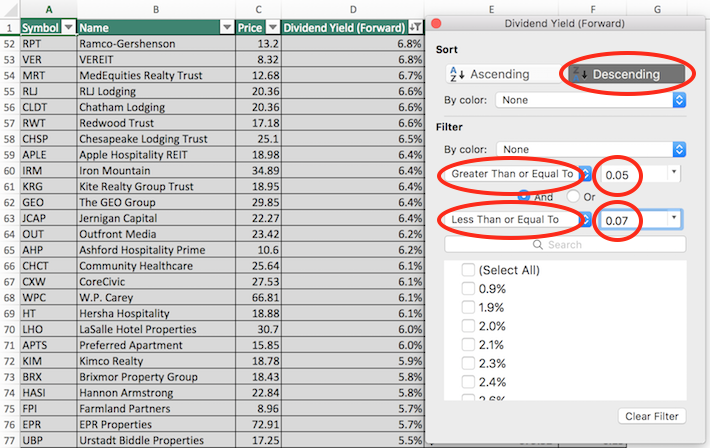
Now that you have the tools to identify high-quality REITs, the next section will show some of the benefits of owning this asset class in a diversified investment portfolio.
Why Invest in REITs?
REITs are, by design, a fantastic asset class for investors looking to generate income.
Thus, one of the primary benefits of investing in these securities is their high dividend yields.
The currently high dividend yields of REITs is not an isolated occurrence. In fact, this asset class has traded at a higher dividend yield than the S&P 500 for decades.
Related: Dividend investing versus real estate investing.
The high dividend yields of REITs are due to the regulatory implications of doing business as a real estate investment trust.
In exchange for listing as a REIT, these trusts must pay out at least 90% of their net income as dividend payments to their unitholders (REITs trade as units, not shares).
Sometimes you will see a payout ratio of less than 90% for a REIT, and that is likely because they are using funds from operations, not net income, in the denominator for REIT payout ratios (more on that later).
REIT Financial Metrics
REITs run unique business models. More than the vast majority of other business types, they are primarily involved in the ownership of long-lived assets.
From an accounting perspective, this means that REITs incur significantnon-cash depreciation and amortization expenses.
How does this affect the bottom line of REITs?
Depreciation and amortization expenses reduce a company’s net income, which means that sometimes a REIT’s dividend will be higher than its net income, even though its dividends are safe based on cash flow.
Related: How To Value REITs
To give a better sense of financial performance and dividend safety, REITs eventually developed the financial metric funds from operations, or FFO.
Just like earnings, FFO can be reported on a per-unit basis, giving FFO/unit – the rough equivalent of earnings-per-share for a REIT.
FFO is determined by taking net income and adding back various non-cash charges that are seen to artificially impair a REIT’s perceived ability to pay its dividend.
For an example of how FFO is calculated, consider the following net income-to-FFO reconciliation from Realty Income (O), one of the largest and most popular REIT securities.

Source: Realty Income Annual Report
In 2022, net income was $869 million while FFO available to stockholders was above $2.4 billion, a sizable difference between the two metrics. This shows the profound effect that depreciation and amortization can have on the GAAP financial performance of real estate investment trusts.
The Top 7 REITs Today
Below we have ranked our top 7 REITs today based on expected total returns.
Expected total returns are in turn made up from dividend yield, expected growth on a per unit basis, and valuation multiple changes. Expected total return investing takes into account income (dividend yield), growth, andvalue.
Note: The REITs below have not been vetted for safety. These are high expected total return securities, but they may come with elevated risks.
We encourage investors to fully consider the risk/reward profile of these investments.
For the Top 10 REITs each month with 4%+ dividend yields, based on expected total returns and safety, see our Top 10 REITs service.
Top REIT #7: Douglas Emmett Inc. (DEI)
- •Expected Total Return: 21.3%
- •Dividend Yield: 6.1%
Douglas Emmett is the largest office landlord in Los Angeles and Honolulu, with a 38% average market share of office space in its submarkets. The REIT generates 86% of its revenue from its office portfolio and 14% of its revenue from its multifamily portfolio. It has approximately 2,700 office leases in its portfolio, with annual revenue of $1 billion.

Source: Investor Presentation
The merits of being the largest office landlord in Los Angeles are obvious, as Los Angeles County is the third-largest city in the world, with GDP of $1 trillion, behind only Tokyo and New York. The dominant position of Douglas Emmett creates operational synergies. In addition, the REIT benefits from high barriers to entry, which reduce competition. Moreover, the proximity to premier housing attracts affluent tenants, who offer reliable cash flows to the company.
In early May, Douglas Emmett reported (5/2/23) financial results for the first quarter of fiscal 2023. Revenue grew 5.7% thanks to new multifamily units but adjusted funds from operations (FFO) per share dipped -5% over the prior year’s quarter due to increased interest expense.
Click here to download our most recent Sure Analysis report on DEI (preview of page 1 of 3 shown below):

Top REIT #6: American Assets Trust (AAT)
- •Expected Total Return: 21.4%
- •Dividend Yield: 6.8%
American Assets Trust is headquartered in San Diego, California, and has great experience in acquiring, improving and developing office, retail and residential properties throughout the U.S., primarily in Southern California, Northern California, Oregon, Washington and Hawaii.
Its office portfolio and its retail portfolio comprise of approximately 4.0 million and 3.1 million square feet, respectively. AAT also owns more than 2,000 multifamily units.
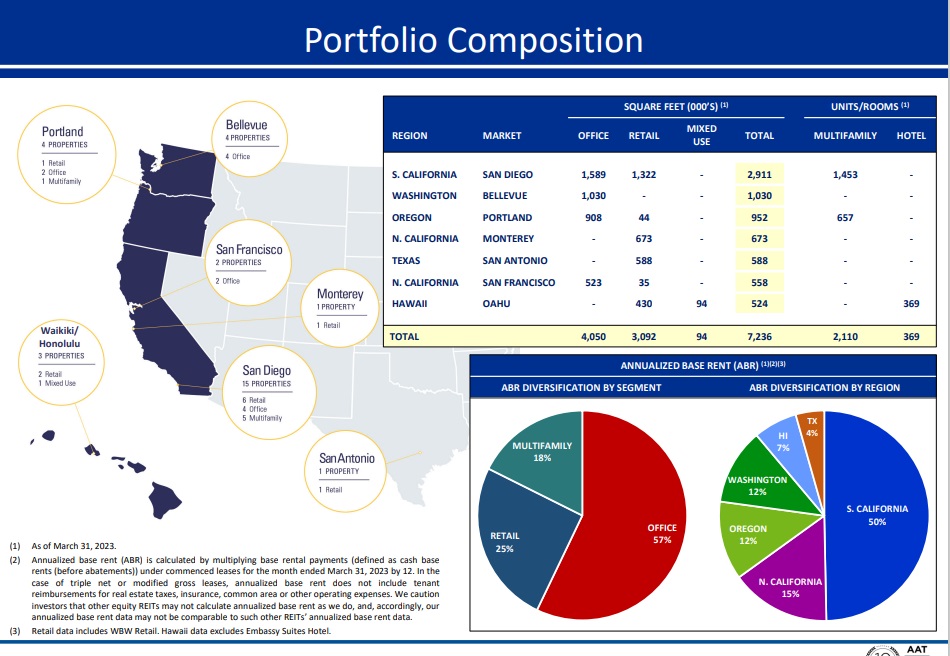
Source: Investor Presentation
In late April, AAT reported (4/25/23) financial results for the first quarter of fiscal 2023. Same-store net operating income grew 6.5% and funds from operations (FFO) per share grew 16% over the prior year’s quarter.
The positive performance resulted primarily from a settlement payment received but also from rent hikes and increased tourism in Hawaii, partly offset by higher operating expenses and interest expense. It slightly improved its guidance for its FFO per share in 2023, from $2.16-$2.30 to $2.23-$2.33.
Click here to download our most recent Sure Analysis report on AAT (preview of page 1 of 3 shown below):
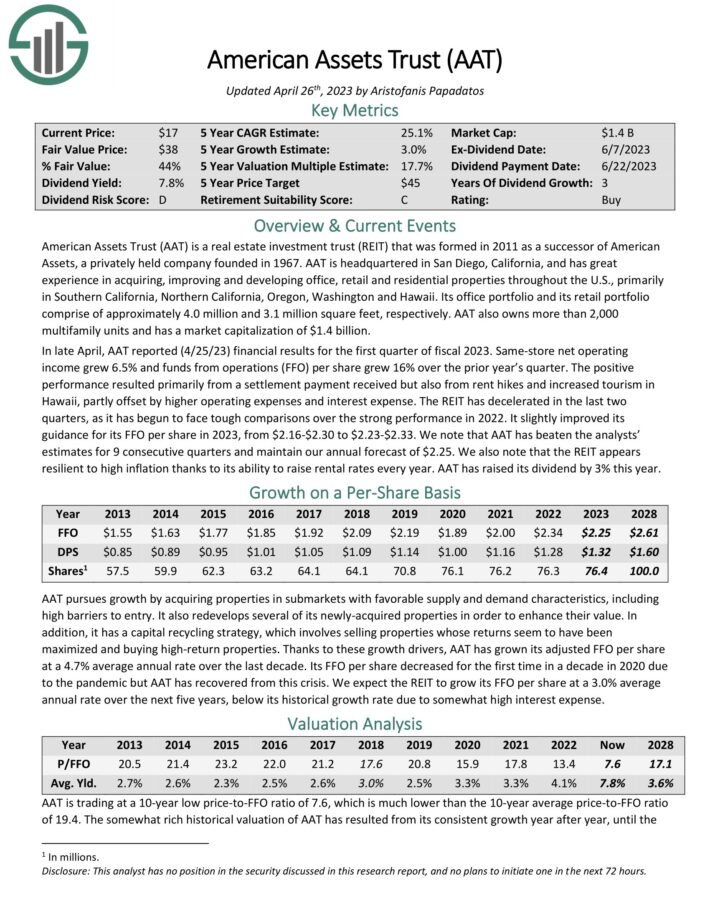
Top REIT #5: Piedmont Office Realty Trust (PDM)
- •Expected Total Return: 22.6%
- •Dividend Yield: 12.2%
Piedmont Office Realty Trust, Inc. owns, manages, develops, redevelops, and operates high-quality office properties located primarily in sub-markets within seven major Eastern U.S. office markets.
The REIT derives most of its revenues from U.S. government entities, business services companies, and financial institutions in the Sunbelt region. PDM is fully integrated and self-managed.
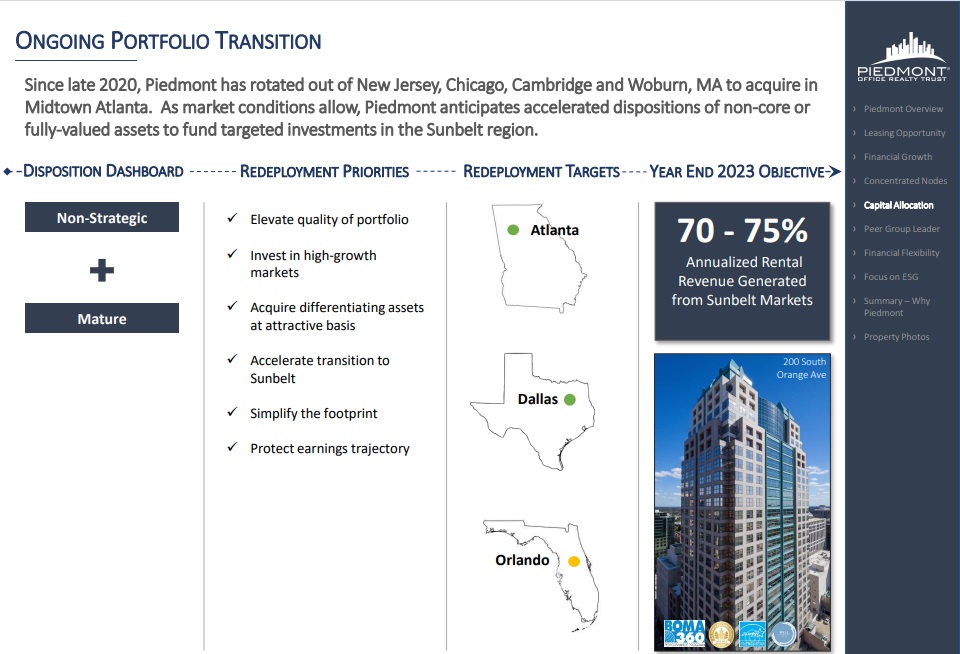
Source: Investor Presentation
On May 1st, 2023, Piedmont reported first quarter 2023 results. The company reported core funds from operations (FFO) of $0.46 per share for the quarter, a 9.8% decrease compared to last year’s results in the first quarter, mostly due to an increase in interest expense.
PDM saw a 1.5% decrease in same store net operating income on a cash basis during the first quarter, due to 2% of the company’s annualized lease revenue expiring and a 600K square foot increase in executed leases yet to commence or under rental abatement. The company leased 544,000 square feet in the quarter, including 270,000 square feet of new tenant leasing.
Click here to download our most recent Sure Analysis report on Piedmont (preview of page 1 of 3 shown below):

Top REIT #4: Office Properties Income Trust (OPI)
- •Expected Total Return: 22.9%
- •Dividend Yield: 12.8%
Office Properties Income Trust is a REIT that currently owns more than 160 buildings, which are primarily leased to single tenants with high credit quality. The REIT’s portfolio currently has a 90.6% occupancy rate and an average building age of 17 years. The U.S. Government is the largest tenant of OPI, as it represents 20% of the annual rental income of the REIT.
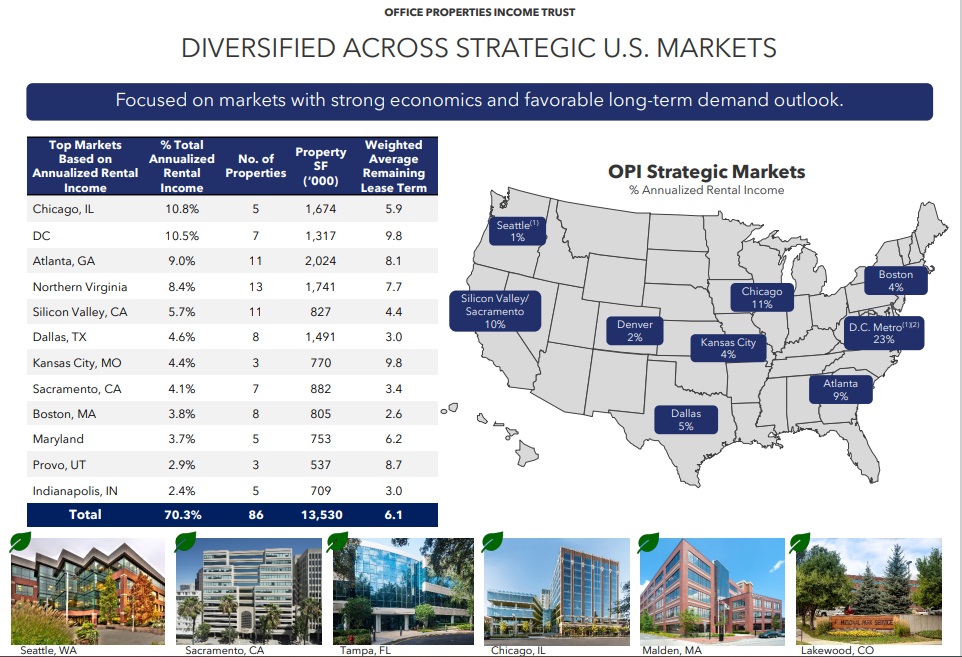
Source: Investor Presentation
In late April, OPI reported (4/26/2023) financial results for the first quarter of fiscal 2023. The occupancy rate edged down sequentially from 90.6% to 90.5% and normalized funds from operations (FFO) per share fell -16% over the prior year’s quarter, from $1.30 to $1.09. More than 90% of the debt of OPI is at fixed rates but we expect interest expense to increase this year due to high interest rates.
Click here to download our most recent Sure Analysis report on OPI (preview of page 1 of 3 shown below):
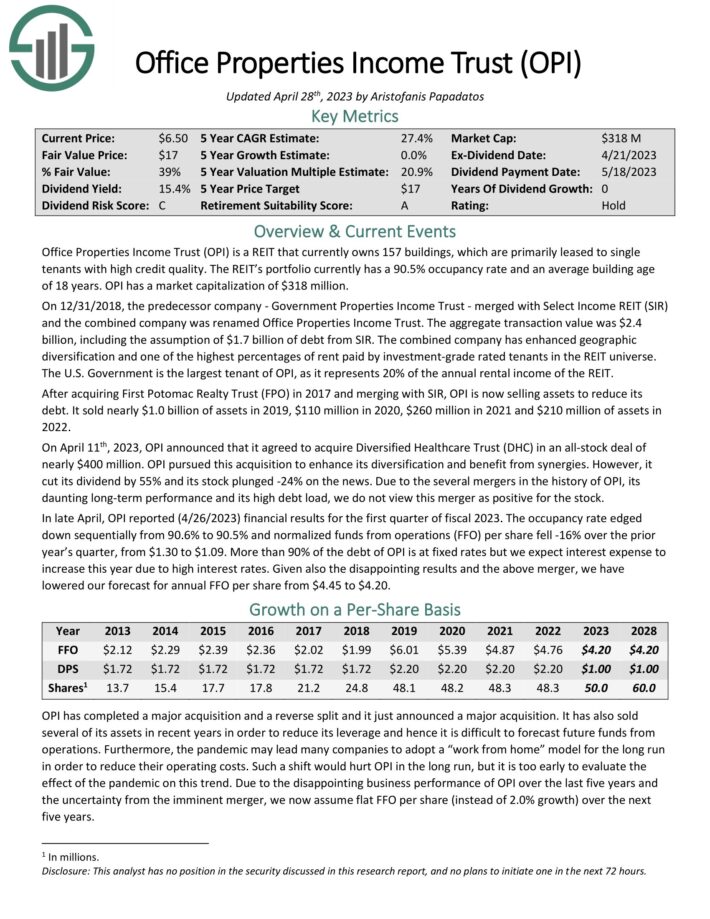
Top REIT #3: Innovative Industrial Properties (IIPR)
- •Expected Total Return: 24.0%
- •Dividend Yield: 9.9%
Innovative Industrial Properties, Inc. is a single-use “specialty REIT” that exclusively focuses on owning properties used for the cultivation and production of marijuana. Because the industry is in the midst of a legal transition, there are constraints on capital available to businesses engaged in the cannabis business. IIPR owns ~111 properties in 19 states.

Source: Investor Presentation
On May 8th, 2023, Innovative Industrial announced its Q1 results for the period ending March 31st, 2023. For the quarter, revenues and normalized AFFO/share were $76.1 million and $2.25, an increase of 17.9% and 10.3%, respectively. The company’s growth was primarily driven by the nine properties that were acquired throughout the year. Contractual rental escalations at certain properties also boosted results.
As of March 31st, 2023, 100% of IIPR’s properties were leased with a weighted average remaining lease term of approximately 15.1 years. That’s two months less than the previous quarter’s WALE, but it is still a very impressive total. The company collected 98% during the quarter.
Click here to download our most recent Sure Analysis report on IIPR (preview of page 1 of 3 shown below).

Top REIT #2: Brandywine Realty Trust (BDN)
- •Expected Total Return: 26.8%
- •Dividend Yield: 17.2%
Brandywine Realty owns, develops, leases and manages an urban town center and transit-oriented portfolio which includes 163 properties in Philadelphia, Austin and Washington, D.C. The REIT has a market capitalization of $1.1 billion and generates 74% of its operating income in Philadelphia, 22% of its operating income in Austin and the remaining 4% in Washington, D.C.
As Brandywine Realty Trust generates the vast portion of its operating income in Philadelphia and Austin, it is worth noting the advantages of these two areas. According to official reports, Philadelphia has the highest growth rate of highly educated citizens since 2008 while Austin is the fastest-growing metropolitan area, the best place to start business and it has retrieved all the jobs lost due to the pandemic.
Click here to download our most recent Sure Analysis report on BDN (preview of page 1 of 3 shown below):
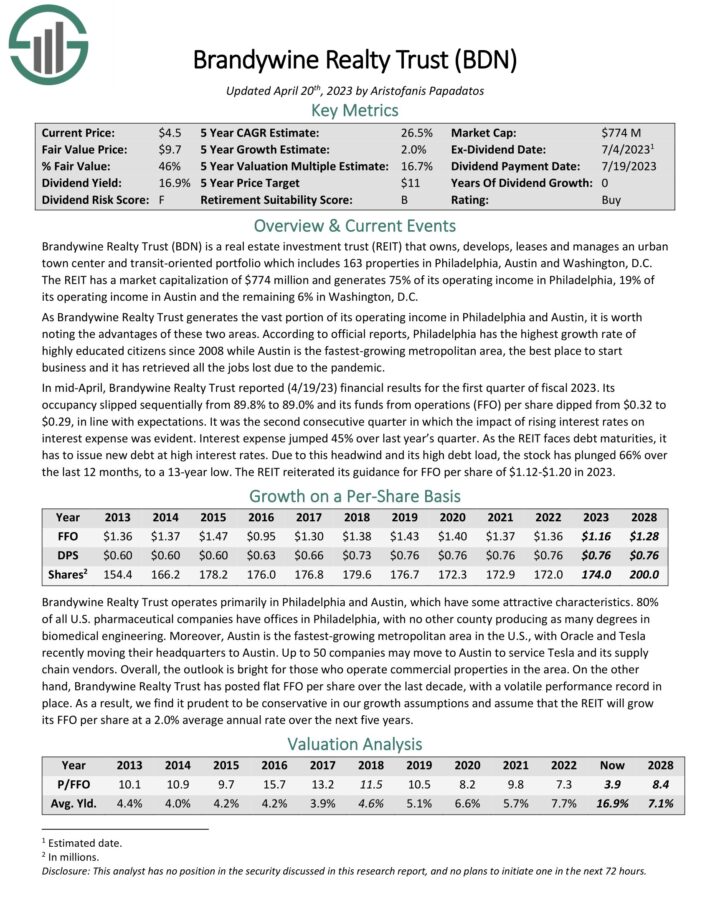
Top REIT #1: SL Green Realty (SLG)
- •Expected Total Return: 26.9%
- •Dividend Yield: 12.5%
SL Green is a self-managed REIT that manages, acquires, develops, and leases New York City Metropolitan office properties. In fact, the trust is the largest owner of office real estate in New York City, with the majority of its properties located in midtown Manhattan. It is Manhattan’s largest office landlord, with more than 40 buildings totaling nearly 30 million square feet.

Source: Investor Presentation
SL Green also benefits from its trophy assets, such as 450 Park Avenue and 245 Park Avenue, where the company can command high rents from tenants and where demand remains high. The company’s regular asset sales of non-core assets aim to further strengthen the portfolio, which should help with demand and occupancy rates in the long run.
Despite ongoing interest rate challenges, the current payout appears to be manageable. We expect SL Green to generate $5.40 in FFO per share in 2023, resulting in a dividend payout ratio of ~60%.
Click here to download our most recent Sure Analysis report on SL Green Realty Corp. (SLG) (preview of page 1 of 3 shown below):
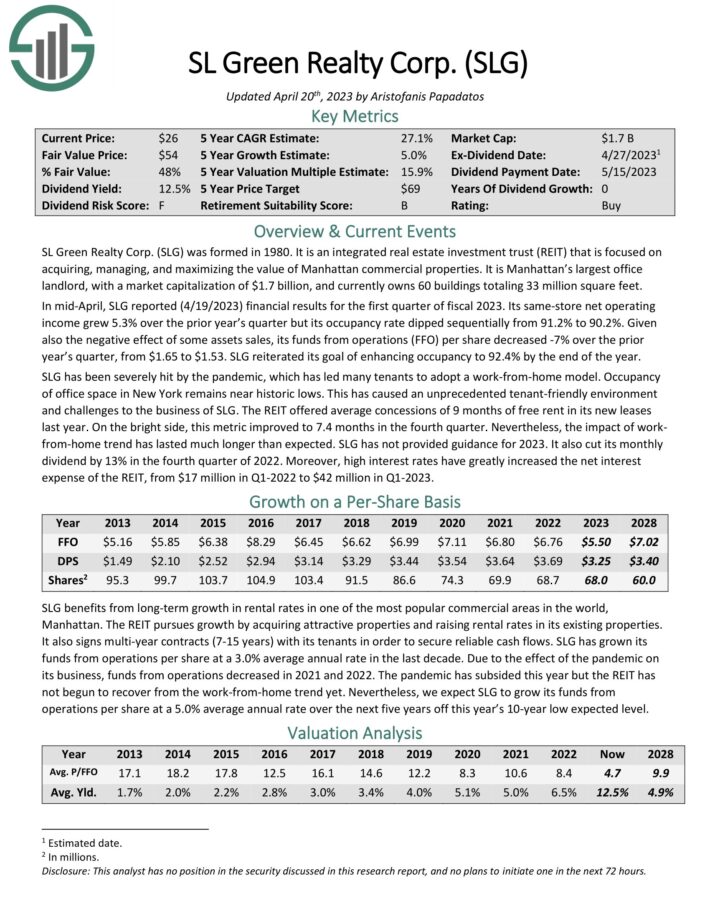
Final Thoughts
The REIT Spreadsheet list in this article contains a list of publicly-traded Real Estate Investment Trusts.
However, this database is certainly not the only place to find high-quality dividend stocks trading at fair or better prices.
In fact, one of the best methods to find high-quality dividend stocks is looking for stocks with long histories of steadily rising dividend payments. Companies that have increased their payouts through many market cycles are highly likely to continue doing so for a long time to come.
Related:




